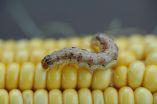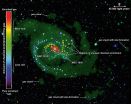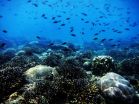Obesity and weight loss change splicing pattern of obesity and type 2 diabetes genes
2015-05-21
(Press-News.org) Alternative splicing of obesity and type 2 diabetes related genes may contribute to the pathophysiology of obesity, according to research from the University of Eastern Finland. Obesity leads to changes in the splicing pattern of metabolically relevant genes such as TCF7L2 and INSR, resulting in impaired insulin action. However, weight loss, induced by either obesity surgery or a very low-calorie diet, reverses these changes. The findings, presented by Dorota Kaminska, MSc, in her doctoral dissertation, increase our understanding of splicing dysregulations in obesity and can result in a new, more targeted treatment and more accurate diagnostics of metabolic disorders.
Both obesity and type 2 diabetes are complex diseases that are caused by a combination of genetic, environmental and lifestyle factors. Obesity is strongly associated with other metabolic complications including insulin resistance and type 2 diabetes, however the mechanisms linking the two conditions remain unclear.
Alternative splicing is the process by which a single gene produces more than one protein. Almost all human genes undergo some form of alternative splicing, which compensates for the relatively low number of genes present in the human genome. The study focused on determining the effects of obesity and weight loss on alternative splicing of metabolically active genes (TCF7L2 and INSR). Furthermore, the study identified alternatively spliced genes in the genomic regions associated with obesity risk, demonstrating that splicing of the TCF7L2, INSR and MSH5 genes in subcutaneous fat is regulated by weight loss. The study also found that body mass index is a main determinant of TRA2B, BAG6 and MSH5 splicing in subcutaneous fat; however, the functional consequences of this finding require further investigation.
The study carried out at the Department of Clinical Nutrition of the University of Eastern Finland was based on data from the Kuopio Obesity Surgery (KOBS), very low calorie diet (VLCD), Metabolic Syndrome in Men (METSIM) and European Network on Functional Genomics of Type 2 Diabetes (EUGENE2) studies.
The researchers suggest that modulating alternative splicing may result in a new therapeutic approach against obesity-associated phenotypes.
INFORMATION:
The original articles were published in Diabetes, Diabetologia and Adipocyte journals.
The doctoral dissertation, entitled Regulation of alternative splicing in obesity and weight loss, is available for download at http://epublications.uef.fi/pub/urn_isbn_978-952-61-1785-0/urn_isbn_978-952-61-1785-0.pdf
For further information, please contact:
Dorota Kaminska, University of Eastern Finland, Institute of Public Health and Clinical Nutrition, tel. +358443428045, email: dorota.kaminska@uef.fi
ELSE PRESS RELEASES FROM THIS DATE:
2015-05-21
A new study from North Carolina State University and Clemson University finds the toxin in a widely used genetically modified (GM) crop is having little impact on the crop pest corn earworm (Helicoverpa zea) - which is consistent with predictions made almost 20 years ago that were largely ignored. The study may be a signal to pay closer attention to warning signs about the development of resistance in agricultural pests to GM crops.
At issue is genetically engineered corn that produces a Bacillus thuringiensis (Bt) protein which, in turn produces a toxin called Cry1Ab. ...
2015-05-21
This news release is available in German. A method known as navigated transcranial magnetic stimulation (nTMS) has been gaining importance in neurosurgery for some time now. Among other applications, it is used to map brain tumors before an operation and to test whether important regions of the brain, for example motor and language areas, are affected. Doctors at the Technische Universität München (TUM) have now shown that preoperative nTMS analysis of motor areas improves the prognosis of patients with malignant brain tumors.
With the help of nTMS, it ...
2015-05-21
ANN ARBOR, Mich. -- A team of researchers at the University of Michigan Health System has developed a risk prediction model that helps identify which hepatitis C patients have the most urgent need for new anti-viral drugs.
Rallying baby boomers to be screened for hepatitis C took off as effective treatments emerged to wipe out the liver-damaging virus. But high costs that can rise to more than $80,000 for a round of treatment have complicated the promise of providing curative treatment for the estimated 3.2 million people in the United States with hepatitis C.
For ...
2015-05-21
Limiting temperature rise by 2100 to less than 1.5°C is feasible, at least from a purely technological standpoint, according to the study published in the journal Nature Climate Change by researchers at the International Institute for Applied Systems Analysis (IIASA), the Potsdam Institute for Climate Impact Research (PIK), and others. The new study examines scenarios for the energy, economy, and environment that are consistent with limiting climate change to 1.5°C above pre-industrial levels, and compares them to scenarios for limiting climate change to 2°C. ...
2015-05-21
(PARIS, FRANCE) - New data released today at EuroPCR 2015 suggest that thickening of the valve leaflets following implantation of a transcatheter or surgical aortic valve bioprosthesis is relatively rare, not linked to short-term clinical events, and not unique to any one type of valve. Longer-term follow-up and larger studies looking specifically at this issue are warranted, experts said here at a special session devoted to the emerging understanding of the phenomenon.
"At the present time, there is no evidence to support a change in patient selection, procedural aspects, ...
2015-05-21
In January 2015 a report published as a research letter to the New England Journal of Medicine (NEJM) (1) found that a 3rd generation e-cigarette (an e-cigarette with variable power settings) set to the maximum power and long puff duration generated levels of formaldehyde that, if inhaled in this way throughout the day, would several times exceed formaldehyde levels that smokers get from cigarettes. Media worldwide accordingly reported this new health hazard of e-cigarettes.
A new study published online today in the scientific journal Addiction took a closer look at ...
2015-05-21
A team of Australian and Spanish astronomers have caught a greedy galaxy gobbling on its neighbours and leaving crumbs of evidence about its dietary past.
Galaxies grow by churning loose gas from their surroundings into new stars, or by swallowing neighbouring galaxies whole. However, they normally leave very few traces of their cannibalistic habits.
A study published today in Monthly Notices of the Royal Astronomical Society (MNRAS) not only reveals a spiral galaxy devouring a nearby compact dwarf galaxy, but shows evidence of its past galactic snacks in unprecedented ...
2015-05-21
The success of corals that adapt to survive in the world's hottest sea could contribute to their demise through global warming, according to new research.
Researchers from the University of Southampton and the New York University Abu Dhabi found that local adaptation to high salinity levels in the southern Persian/Arabian Gulf (PAG) may prevent coral escaping their fate, as they lose their superior heat tolerance in waters with normal salinity levels.
The research is published this week in The ISME Journal, a world leading publication platform for ecological research, ...
2015-05-21
Malaria is a cruel and disabling disease that targets victims of all ages. Even now, it is estimated to kill one child every minute. Recent progress in halting the spread of the disease has hinged on the use of insecticide-treated bed nets and spraying programmes that target the insect that spreads the disease, the African malaria mosquito (Anopheles gambiae). However, the insects are fighting back, developing resistance to insecticides such as pyrethroid that control their numbers, forcing Brian Foy and Jacob Meyers from Colorado State University to think of alternative ...
2015-05-21
Report shows 38 MPs have accepted over £60,000 of industry hospitality since 2010
More than half of these MPs are from constituencies where the number of smoking related deaths exceeds the national average
20 of the 38 MPs who accepted hospitality voted against plain packaging
An investigation by The BMJ today asks to what extent is the tobacco industry able to reach out and influence parliamentarians?
It shows that since 2010, 38 MPs -- 29 Conservatives, eight Labour, and one independent -- have accepted over £60,000 worth of tobacco industry hospitality, ...
LAST 30 PRESS RELEASES:
[Press-News.org] Obesity and weight loss change splicing pattern of obesity and type 2 diabetes genes


